-
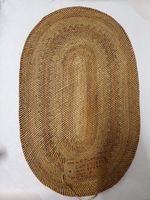 Mat
Mat This small mat was from a previously unknown tribe, but has been attributed to the Yakutat through Smithsonian records. It has been severely faded on one side, but is still bright and vibrant on the reverse.
-
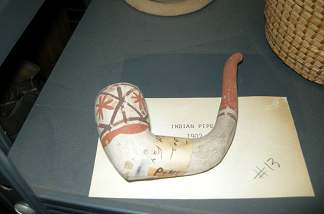 Indian Pipe
Indian Pipe This is a ceramic pipe of unknown tribal origin. This piece shows possible evidence of cross-cultural contact as the color is indicative of pueblo pottery but the shape is not similar to other examples. Its shape is due to the possible copying of European style pipe by a native artist.
-
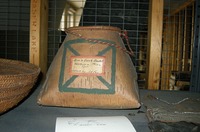 Basket
Basket This basket, of unknown tribal origin, is from Minnesota and collected by A. H. Fay. Baskets from this region were made of White Birch bark that was harvested by the tribal groups of the region. White Birch Bark was valuable in its use for basket making due to its durability and that it was waterproof.
-
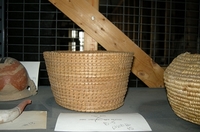 Basket
Basket This Pima basket was collected by L.C. Fletcher in Arizona. Its tight weave is still in excellent condition.
-
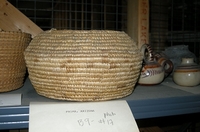 Basket
Basket This coiled basket was collected in Port Clarence, Alaska for the Interior Department Collection. Based on the location where it was collected, it was probably made by an Inupiat maker.
-
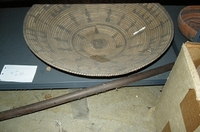 Basket
Basket This coiled basket tray was collected from the White Mountain Apache of Arizona by C. E. Bates. The design includes crosses, perhaps showing the influence of Christianity and colonization on the tribe.
-
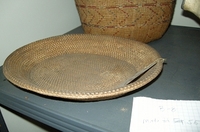 Basket
Basket This woven basket was collected for the Interior Department Collection in Alaska.
-
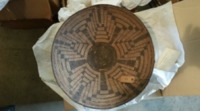 Basket
Basket This coiled basket tray was acquired by Mrs. Mary Manning Fletcher, published as Mrs. L.C. Fletcher, from the Pima tribe in Arizona. The Pima, also known as the Akimel O'odham or “River People” are renowned for their intricate weaves. The entire bowl is marked by one, large, woven, star shaped design.
-
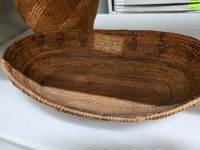 Basket
Basket This basket was purchased in Carson City, Nevada, by A.H. Fay. We have several pieces in the collection purchased there by Fay, suggesting that he frequented a shop of Indigenous art there.
-
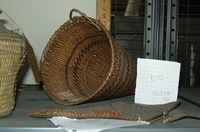 Basket
Basket This basket, of unknown tribal origin, is in a conical shape. Baskets similar in shape to these are often used as load bearing baskets, meant for the transport of objects on one's back. Though the tribal origin is unknown, this piece was collected in Carson City, Nevada, along with several other pieces in the collection donated by A. H. Fay. It is possible that Fay frequented a store in the area that sold Indigenous art. alluding to the fact that its origins lie in the tribes of that region. It is possible that it is of the Maidu tribe, as its place of origin lies near the Maidu’s ancestral land.
-
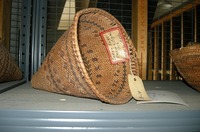 Basket
Basket This basket, collected by A. H. Fay in Carson City Nevada, is in the style of a carrying basket that would be placed upon one’s back, though it is too small for practical use. This connection and inference can be made due to its conical shape.
-
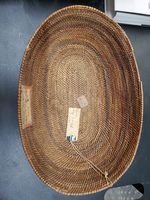 Basket
Basket This may be the only piece in the collection by a named maker. The tiny, faded tag may read “Minky, 12 y(ears old), Paiute squaw.” While we would today consider squaw to be a derogatory term for an Indigenous woman, it was used to market this basket when it was sold in Carson City, Nevada in 1916.
-
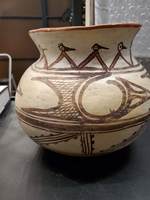 Jar-First Band-Conventional Bird
Jar-First Band-Conventional Bird This jar has an interesting design, with an upper band comprised of bird heads with geometric designs rather than bodies.
-
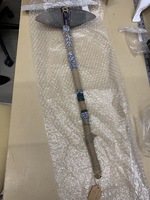 Stone Headed War Club
Stone Headed War Club This stone-headed war club, loaned to Lafayette College by Dr. Freeman Ward, is most likely from either the Rosebud Sioux tribe or Oglala Sioux, a branch of the Lakota people of South Dakota, where Dr. Ward conducted much of his surveying work. Though earlier iterations of this beaded club were used for battle, later iterations were intended for ceremonial use. Dr. Ward’s work as a professor in the Geology department at Lafayette likely led him to loan the object to the college for teaching. Unfortunately, it was placed in storage and never returned.
-
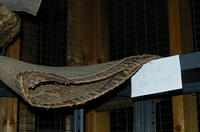 Mat
Mat This woven mat was collected from the Tsimshian tribe in Alaska. According to the Canadian Museum of History, the use of cedar-bark fiber for clothing and baskets distinguishes the Tsimshian from the Haida and the Tlingit, who favoured spruce-root fiber.
-
Basket
This, now flattened, basket was once used by the peoples of the Tlingit tribe in Alaska. Traveling as a Preysbeterian leader, Sheldon Jackson, made an effort to “civilize” the Indigenous peoples. Simultaneously, Jackson supplied trained medical professionals to isolated communities. During his time in Alaska, he collected Indigenous art and material culture, some of which he gave to Mrs. J.C. Kinney to be sold to help young Alaskan natives afford to build houses. It is likely that the Smithsonian acquired this basket from one of her stops during her traveling sale.
-
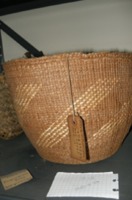 Basket
Basket This simply patterned large basket was collected by Mrs. Mary Manning Fletcher, more famously known as Mrs. L.C. Fletcher, from the Tlingit tribe. The basket is likely composed of spruce root, fern stem, and bear grass. Three different color strips are featured in its design: tan, yellow and red. The tan strips compose the majority of the basket. There are slanted vertical lines which are composed of alternating red and yellow segments. Fletcher was likely gifted it for a small price while conducting her anthropological work in Alaska before it made its way to the Smithsonian.
-
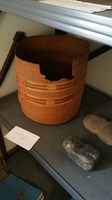 Basket
Basket We can tell that this is a Tlingit basket, rather than Haida, because the weaving jogs down to the right, a result of weaving the basket right side-up, as opposed to Haida weavers who weave the basket upside down, resulting in the stitches jogging up to the right.
-
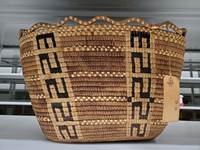 Basket
Basket This basket was collected from the Skagit River by L.C. Fletcher. It has a delicate decorative rim, which has come loose from the rest of the basket.
-
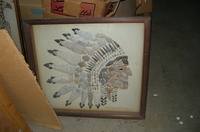 Indian points collection
Indian points collection This mosaic image is formed from a collection of Indigenous arrow heads. The inscription notes that the arrowheads were collected, assembled, and mounted by Harry H. Perkins in 1936. Geology Professor C. K. Cabeen of Lafayette College purchased another arrowhead collection from Perkins the following year, and possibly collected this one at the same time.
-
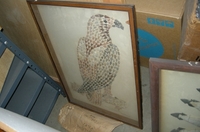 American Indian Bird Points (490)
American Indian Bird Points (490) This mosaic image is formed from a collection of Indigenous arrow heads. The inscription notes that the arrowheads were collected, assembled, and mounted by Harry H. Perkins in 1937 for Geology Professor C. K. Cabeen of Lafayette College. Here, Indigenous objects were transformed from utilitarian hunting objects to an image that reflects the professor’s interest in collecting, stone, and education.
-
 Basket
Basket This basket is a design commonly known as a Navajo wedding basket, which may be used in ceremonies to hold corn pollen. Today, designs like this are often made to be sold to tourists.
-
Ladle
This ladle was contaminated with arsenic, and thus has been less studied than other objects in the collection. It is more common for objects of organic material, such as woven baskets, to be contaminated, as arsenic was used as pest control in early museum practices.
-
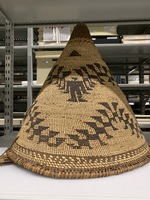 Basket
Basket This basket is from the Maidu tribe of Northern California. The basket was most likely used for the transport of objects upon one's back. The V shaped designs on this basket most likely depict the patterns of migrating geese. Baskets such as these are discussed in Basketry Designs of the Maidu Indians of California, written by the collector, Ronald B. Dixon. As he wrote, “Two other designs are representations of birds, the “geese flying ” and the “duck’s wing.” One form of one of these designs is apparently meant for a flock of geese in flight, their triangular order being well shown in the arrangement of the points of the design.”
-
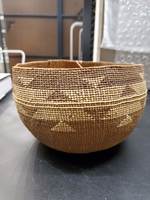 Woven Hat
Woven Hat This piece is also an example of basketry from the Hupa tribe of California, though not necessarily used as a container. This is an example of a woven hat, traditionally worn by women. This piece was assumed to be a container like the other baskets in the collection for many years, until recent research into the collection revealed that it was in fact used as a hat.
 Mat This small mat was from a previously unknown tribe, but has been attributed to the Yakutat through Smithsonian records. It has been severely faded on one side, but is still bright and vibrant on the reverse.
Mat This small mat was from a previously unknown tribe, but has been attributed to the Yakutat through Smithsonian records. It has been severely faded on one side, but is still bright and vibrant on the reverse. Indian Pipe This is a ceramic pipe of unknown tribal origin. This piece shows possible evidence of cross-cultural contact as the color is indicative of pueblo pottery but the shape is not similar to other examples. Its shape is due to the possible copying of European style pipe by a native artist.
Indian Pipe This is a ceramic pipe of unknown tribal origin. This piece shows possible evidence of cross-cultural contact as the color is indicative of pueblo pottery but the shape is not similar to other examples. Its shape is due to the possible copying of European style pipe by a native artist. Basket This basket, of unknown tribal origin, is from Minnesota and collected by A. H. Fay. Baskets from this region were made of White Birch bark that was harvested by the tribal groups of the region. White Birch Bark was valuable in its use for basket making due to its durability and that it was waterproof.
Basket This basket, of unknown tribal origin, is from Minnesota and collected by A. H. Fay. Baskets from this region were made of White Birch bark that was harvested by the tribal groups of the region. White Birch Bark was valuable in its use for basket making due to its durability and that it was waterproof. Basket This Pima basket was collected by L.C. Fletcher in Arizona. Its tight weave is still in excellent condition.
Basket This Pima basket was collected by L.C. Fletcher in Arizona. Its tight weave is still in excellent condition. Basket This coiled basket was collected in Port Clarence, Alaska for the Interior Department Collection. Based on the location where it was collected, it was probably made by an Inupiat maker.
Basket This coiled basket was collected in Port Clarence, Alaska for the Interior Department Collection. Based on the location where it was collected, it was probably made by an Inupiat maker. Basket This coiled basket tray was collected from the White Mountain Apache of Arizona by C. E. Bates. The design includes crosses, perhaps showing the influence of Christianity and colonization on the tribe.
Basket This coiled basket tray was collected from the White Mountain Apache of Arizona by C. E. Bates. The design includes crosses, perhaps showing the influence of Christianity and colonization on the tribe. Basket This woven basket was collected for the Interior Department Collection in Alaska.
Basket This woven basket was collected for the Interior Department Collection in Alaska. Basket This coiled basket tray was acquired by Mrs. Mary Manning Fletcher, published as Mrs. L.C. Fletcher, from the Pima tribe in Arizona. The Pima, also known as the Akimel O'odham or “River People” are renowned for their intricate weaves. The entire bowl is marked by one, large, woven, star shaped design.
Basket This coiled basket tray was acquired by Mrs. Mary Manning Fletcher, published as Mrs. L.C. Fletcher, from the Pima tribe in Arizona. The Pima, also known as the Akimel O'odham or “River People” are renowned for their intricate weaves. The entire bowl is marked by one, large, woven, star shaped design. Basket This basket was purchased in Carson City, Nevada, by A.H. Fay. We have several pieces in the collection purchased there by Fay, suggesting that he frequented a shop of Indigenous art there.
Basket This basket was purchased in Carson City, Nevada, by A.H. Fay. We have several pieces in the collection purchased there by Fay, suggesting that he frequented a shop of Indigenous art there. Basket This basket, of unknown tribal origin, is in a conical shape. Baskets similar in shape to these are often used as load bearing baskets, meant for the transport of objects on one's back. Though the tribal origin is unknown, this piece was collected in Carson City, Nevada, along with several other pieces in the collection donated by A. H. Fay. It is possible that Fay frequented a store in the area that sold Indigenous art. alluding to the fact that its origins lie in the tribes of that region. It is possible that it is of the Maidu tribe, as its place of origin lies near the Maidu’s ancestral land.
Basket This basket, of unknown tribal origin, is in a conical shape. Baskets similar in shape to these are often used as load bearing baskets, meant for the transport of objects on one's back. Though the tribal origin is unknown, this piece was collected in Carson City, Nevada, along with several other pieces in the collection donated by A. H. Fay. It is possible that Fay frequented a store in the area that sold Indigenous art. alluding to the fact that its origins lie in the tribes of that region. It is possible that it is of the Maidu tribe, as its place of origin lies near the Maidu’s ancestral land. Basket This basket, collected by A. H. Fay in Carson City Nevada, is in the style of a carrying basket that would be placed upon one’s back, though it is too small for practical use. This connection and inference can be made due to its conical shape.
Basket This basket, collected by A. H. Fay in Carson City Nevada, is in the style of a carrying basket that would be placed upon one’s back, though it is too small for practical use. This connection and inference can be made due to its conical shape. Basket This may be the only piece in the collection by a named maker. The tiny, faded tag may read “Minky, 12 y(ears old), Paiute squaw.” While we would today consider squaw to be a derogatory term for an Indigenous woman, it was used to market this basket when it was sold in Carson City, Nevada in 1916.
Basket This may be the only piece in the collection by a named maker. The tiny, faded tag may read “Minky, 12 y(ears old), Paiute squaw.” While we would today consider squaw to be a derogatory term for an Indigenous woman, it was used to market this basket when it was sold in Carson City, Nevada in 1916. Jar-First Band-Conventional Bird This jar has an interesting design, with an upper band comprised of bird heads with geometric designs rather than bodies.
Jar-First Band-Conventional Bird This jar has an interesting design, with an upper band comprised of bird heads with geometric designs rather than bodies. Stone Headed War Club This stone-headed war club, loaned to Lafayette College by Dr. Freeman Ward, is most likely from either the Rosebud Sioux tribe or Oglala Sioux, a branch of the Lakota people of South Dakota, where Dr. Ward conducted much of his surveying work. Though earlier iterations of this beaded club were used for battle, later iterations were intended for ceremonial use. Dr. Ward’s work as a professor in the Geology department at Lafayette likely led him to loan the object to the college for teaching. Unfortunately, it was placed in storage and never returned.
Stone Headed War Club This stone-headed war club, loaned to Lafayette College by Dr. Freeman Ward, is most likely from either the Rosebud Sioux tribe or Oglala Sioux, a branch of the Lakota people of South Dakota, where Dr. Ward conducted much of his surveying work. Though earlier iterations of this beaded club were used for battle, later iterations were intended for ceremonial use. Dr. Ward’s work as a professor in the Geology department at Lafayette likely led him to loan the object to the college for teaching. Unfortunately, it was placed in storage and never returned. Mat This woven mat was collected from the Tsimshian tribe in Alaska. According to the Canadian Museum of History, the use of cedar-bark fiber for clothing and baskets distinguishes the Tsimshian from the Haida and the Tlingit, who favoured spruce-root fiber.
Mat This woven mat was collected from the Tsimshian tribe in Alaska. According to the Canadian Museum of History, the use of cedar-bark fiber for clothing and baskets distinguishes the Tsimshian from the Haida and the Tlingit, who favoured spruce-root fiber. Basket This simply patterned large basket was collected by Mrs. Mary Manning Fletcher, more famously known as Mrs. L.C. Fletcher, from the Tlingit tribe. The basket is likely composed of spruce root, fern stem, and bear grass. Three different color strips are featured in its design: tan, yellow and red. The tan strips compose the majority of the basket. There are slanted vertical lines which are composed of alternating red and yellow segments. Fletcher was likely gifted it for a small price while conducting her anthropological work in Alaska before it made its way to the Smithsonian.
Basket This simply patterned large basket was collected by Mrs. Mary Manning Fletcher, more famously known as Mrs. L.C. Fletcher, from the Tlingit tribe. The basket is likely composed of spruce root, fern stem, and bear grass. Three different color strips are featured in its design: tan, yellow and red. The tan strips compose the majority of the basket. There are slanted vertical lines which are composed of alternating red and yellow segments. Fletcher was likely gifted it for a small price while conducting her anthropological work in Alaska before it made its way to the Smithsonian. Basket We can tell that this is a Tlingit basket, rather than Haida, because the weaving jogs down to the right, a result of weaving the basket right side-up, as opposed to Haida weavers who weave the basket upside down, resulting in the stitches jogging up to the right.
Basket We can tell that this is a Tlingit basket, rather than Haida, because the weaving jogs down to the right, a result of weaving the basket right side-up, as opposed to Haida weavers who weave the basket upside down, resulting in the stitches jogging up to the right. Basket This basket was collected from the Skagit River by L.C. Fletcher. It has a delicate decorative rim, which has come loose from the rest of the basket.
Basket This basket was collected from the Skagit River by L.C. Fletcher. It has a delicate decorative rim, which has come loose from the rest of the basket. Indian points collection This mosaic image is formed from a collection of Indigenous arrow heads. The inscription notes that the arrowheads were collected, assembled, and mounted by Harry H. Perkins in 1936. Geology Professor C. K. Cabeen of Lafayette College purchased another arrowhead collection from Perkins the following year, and possibly collected this one at the same time.
Indian points collection This mosaic image is formed from a collection of Indigenous arrow heads. The inscription notes that the arrowheads were collected, assembled, and mounted by Harry H. Perkins in 1936. Geology Professor C. K. Cabeen of Lafayette College purchased another arrowhead collection from Perkins the following year, and possibly collected this one at the same time. American Indian Bird Points (490) This mosaic image is formed from a collection of Indigenous arrow heads. The inscription notes that the arrowheads were collected, assembled, and mounted by Harry H. Perkins in 1937 for Geology Professor C. K. Cabeen of Lafayette College. Here, Indigenous objects were transformed from utilitarian hunting objects to an image that reflects the professor’s interest in collecting, stone, and education.
American Indian Bird Points (490) This mosaic image is formed from a collection of Indigenous arrow heads. The inscription notes that the arrowheads were collected, assembled, and mounted by Harry H. Perkins in 1937 for Geology Professor C. K. Cabeen of Lafayette College. Here, Indigenous objects were transformed from utilitarian hunting objects to an image that reflects the professor’s interest in collecting, stone, and education. Basket This basket is a design commonly known as a Navajo wedding basket, which may be used in ceremonies to hold corn pollen. Today, designs like this are often made to be sold to tourists.
Basket This basket is a design commonly known as a Navajo wedding basket, which may be used in ceremonies to hold corn pollen. Today, designs like this are often made to be sold to tourists. Basket This basket is from the Maidu tribe of Northern California. The basket was most likely used for the transport of objects upon one's back. The V shaped designs on this basket most likely depict the patterns of migrating geese. Baskets such as these are discussed in Basketry Designs of the Maidu Indians of California, written by the collector, Ronald B. Dixon. As he wrote, “Two other designs are representations of birds, the “geese flying ” and the “duck’s wing.” One form of one of these designs is apparently meant for a flock of geese in flight, their triangular order being well shown in the arrangement of the points of the design.”
Basket This basket is from the Maidu tribe of Northern California. The basket was most likely used for the transport of objects upon one's back. The V shaped designs on this basket most likely depict the patterns of migrating geese. Baskets such as these are discussed in Basketry Designs of the Maidu Indians of California, written by the collector, Ronald B. Dixon. As he wrote, “Two other designs are representations of birds, the “geese flying ” and the “duck’s wing.” One form of one of these designs is apparently meant for a flock of geese in flight, their triangular order being well shown in the arrangement of the points of the design.” Woven Hat This piece is also an example of basketry from the Hupa tribe of California, though not necessarily used as a container. This is an example of a woven hat, traditionally worn by women. This piece was assumed to be a container like the other baskets in the collection for many years, until recent research into the collection revealed that it was in fact used as a hat.
Woven Hat This piece is also an example of basketry from the Hupa tribe of California, though not necessarily used as a container. This is an example of a woven hat, traditionally worn by women. This piece was assumed to be a container like the other baskets in the collection for many years, until recent research into the collection revealed that it was in fact used as a hat.